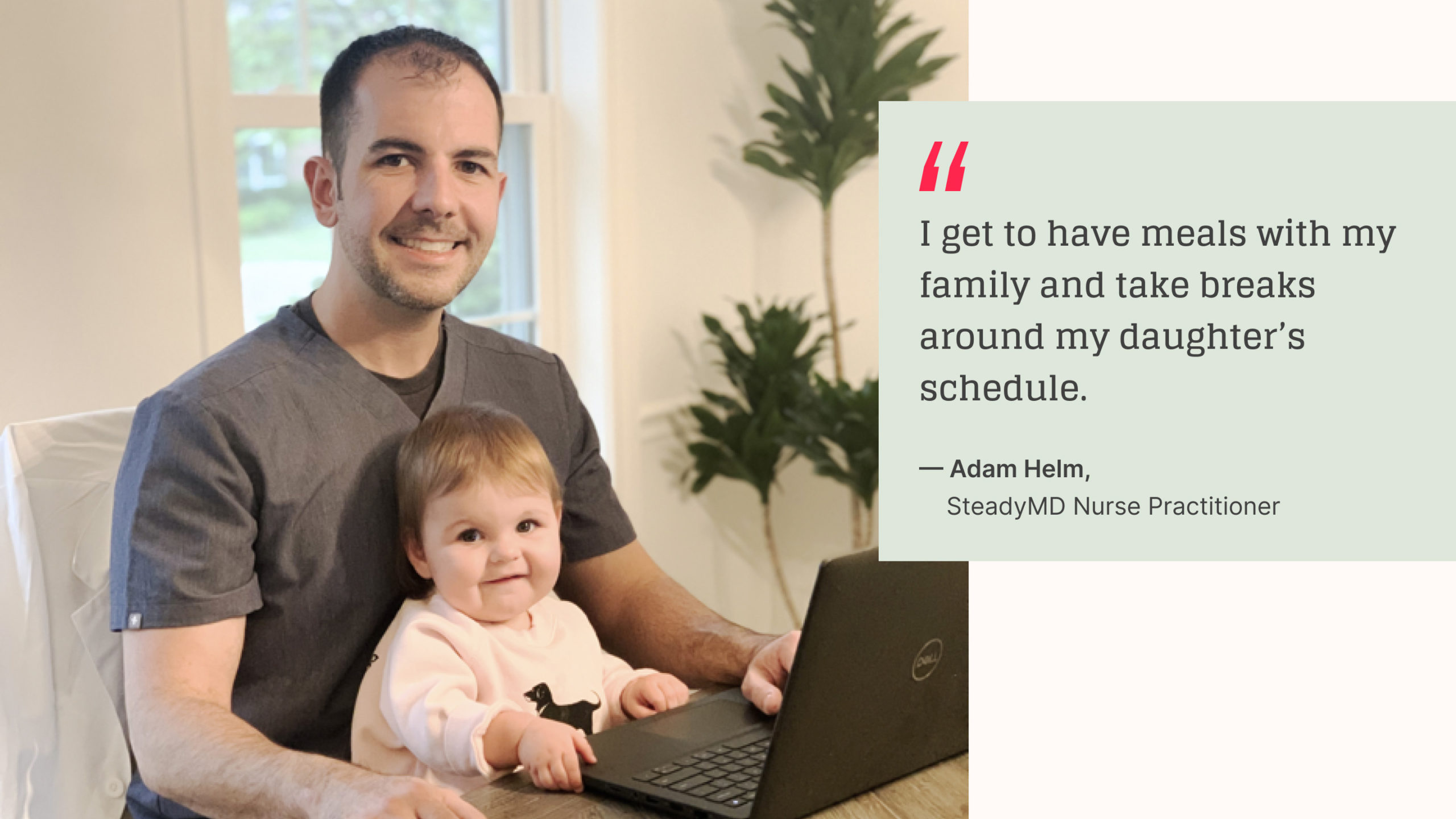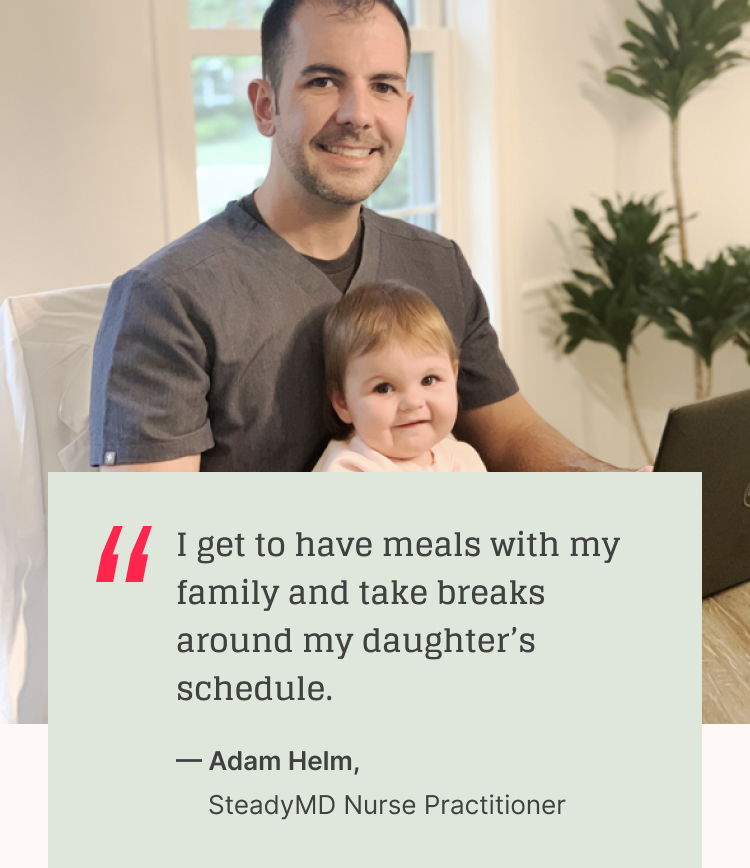Adam Helm, APRN-CNP
Nurse Practitioner, New Father, Accounting Whiz


For Adam Helm, APRN-CNP, that point came in his early 30s after he’d been working as an accountant for five years. He didn’t feel he was giving back to his community or helping people the way he felt he could. So, he bravely left his successful accounting job and pursued a career in healthcare.
When did you decide it was time to work for a telehealth company?
I started practicing as a Nurse Practitioner in 2018, working in several different areas, including Primary Care, Urgent Care, and the Emergency Room (ER). By 2019, I wanted to explore telehealth options. I was working in the ER and the schedule was just not conducive to my new home life. I wanted a better work/life balance and I’ve always believed telemedicine is the future of medicine. The COVID-19 pandemic impacted that decision even more so. I saw it first-hand working in Urgent Care.
How did you hear about SteadyMD?
I first heard about SteadyMD, oddly enough, in workout communities in late 2017! I was very into CrossFit at that time and there was a big advertising campaign for SteadyMD Primary Care (now known as Lemonaid Primary Care Complete) featuring some well-known athletes. I got on the SteadyMD website and started reading through the physician profiles and all of them were athletic in one aspect or another.
“That really piqued my interest knowing I would be part of a community of other clinicians that had the same interests as me and value that type of healthcare.”
What does a typical SteadyMD day look like for you?
You get to pick your own hours so there is a lot of flexibility. I typically work a 12-hour shift from 11am to 11pm. It’s the perfect schedule for me right now because I have a baby at home and I’m a bit of a night owl. Work/life balance is important and with SteadyMD I get that. I enjoy caring for my patients while working from the comfort of my home office.
“This setup enables me to work and be able to spend time with family throughout the day.”
It sounds ideal. How does this schedule differ from your previous working environments?
It’s a stark contrast to my previous work. I never had a choice on when I could take a break or know when I would get my next break. I think employee satisfaction is key to SteadyMD’s success. They really screen who they hire. They look for people who are hard-working and willing to put in the time and do the work, but also they take a step back approach and let them do the work in their time and by their choice.
In your free time, what do you enjoy doing outside of work?
For several years I lived in Salt Lake City, Utah and I really loved being outdoors. Skiing and being in the mountains was great. Now that I’m back in Oklahoma, I still like being outdoors and I do miss the mountains. But I enjoy going on long walks with my family and two dogs. We live in an area with a lot of wildlife and trees.
That’s great you’re able to interact with your family during the day since telehealth can be isolating. How would you describe the tools available to you as a SteadyMD clinician to address this challenge?
There are some great tools. For one SteadyMD partner that I work with, we use an internal chat system among the clinicians. It’s a huge group of us to bounce ideas and questions off of. For example, I’m licensed in Washington state, so I see a lot of patients based in Washington, but I live in Oklahoma. I can hop on the chat and ask someone where there’s a good pharmacy or a nearby Urgent Care to a patient’s location. Also, I’m pretty active on the SteadyMD online community for clinicians. You get immediate response/feedback. Everyone has the software on their phone, so it’s like having people working all the time from all different places and time zones there to respond to you.
“It’s really nice to have different experiences and backgrounds and everyone working together for one common cause and goal.”
Tell us about a patient situation where you felt proud of your work at SteadyMD.
There was a young family that had twins. Both twins were born premature and spent the first month of their lives in the NICU. So, it’s 11pm at night and one twin had an upper respiratory problem with a breathing issue due to congestion. At that time of night, the options were to load up their family and go to the Emergency Room or utilize a telehealth service. They opted for the latter, and I was able to talk to the parents without them having to leave the house for the ER. After determining the situation, I was able to send a nurse out to their house to do an in-person visit, while I assisted virtually as the eyes and ears. We were able to instill confidence in the parents that everything was going to be okay.
“We were there for them in their time of need.”
What is a common misconception about nurse practitioners (NPs)?
The biggest misconception people have about nurse practitioners is that we’re doctors. People try to compare a nurse practitioner to a physician or vice versa. They have different roles and educational backgrounds. However, both are needed in the healthcare system. I’m also in a unique position of being a male nurse and an NP. We’ve come a long way, but there’s still a stigma for males. I’m called “doctor” a lot because of my gender. I often have to correct those around me and state I’m a nurse practitioner, not a physician. At the uniform store, there’s a very small section for male nurse scrubs and a much bigger section for female nurse scrubs. It’s growing, but it’s still a minority demographic for male nurses.
What do you think healthcare will look like in 5-10 years?
A lot more telemedicine in healthcare. I think we’re going to see this progress significantly across all platforms. There will need to be a bridge between nursing staff and physicians, similar to the telehealth appointment I provided to the twin infant. Patients like that still need to be physically assessed and there are technologies out there working on that—some are even already available. Some software can be downloaded to your phone to look inside the ears and listen to the heart, etc. Patients can be assessed and treated based on what clinicians see virtually. If major companies get onboard and start offering these types of telehealth services to their employees, it’s really going to take off.